How To Draw Water Drops In Sai

Add Realistic Water Drops To A Photo With Photoshop
In this Photoshop Furnishings tutorial, we're going to learn how to easily add realistic looking water drops to a photo, as if someone splashed water all over the image. Nosotros're going to exist using a few filters and adjustments to create some random water drop shapes, and and so we'll be making them await like h2o using a few simple layer styles to add shadows and highlights to them.
To cease things off and add together an actress fleck of realism, nosotros'll be using a deportation map to distort the epitome underneath the water drops. It may audio complicated but information technology's all very easy, every bit we'll see.
Here'south the original image I'll be working with:

The original image.
And here's what the prototype will look like after adding the h2o drops:
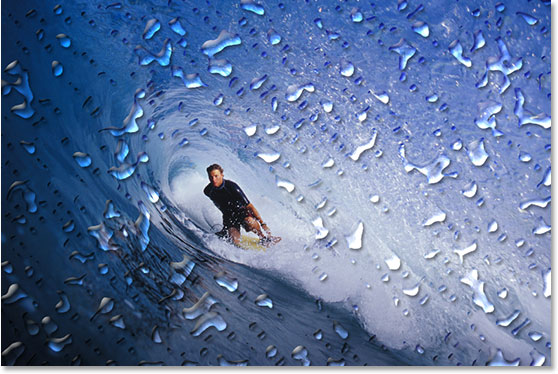
The final upshot.
This tutorial is from our Photo Furnishings series. Allow's become started!
Stride 1: Duplicate The Background Layer
We're going to kickoff off this tutorial in the same fashion nosotros begin many of our tutorials, by duplicating our Background layer. With the image open in Photoshop, we can see in the Layers palette that we currently accept merely one layer, the Background layer, which contains the original epitome:
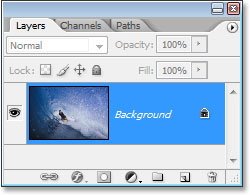
The Layers palette in Photoshop showing the image on the Background layer.
We need to duplicate the Background layer, and to practice that, we can apply the keyboard shortcut Ctrl+J (Win) / Command+J (Mac). If we look back in the Layers palette, we can see that we at present have two copies of the image, with the copy of the Groundwork layer (which Photoshop has named "Layer i") higher up the original:
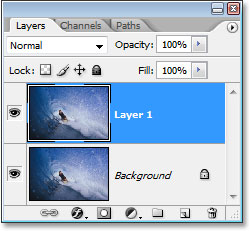
Press "Ctrl+J" (Win) / "Command+J" (Mac) to duplicate the Background layer.
Footstep 2: Add A New Blank Layer Above The Indistinguishable Layer
Next, we need to add a new blank layer above our newly-created duplicate layer. Let's use the keyboard shortcut for that likewise, which is Shift+Ctrl+Alt+N (Win) / Shift+Command+Choice+N (Mac). By adding the Alt/Option key in there, that tells Photoshop non to bother popping up the dialog box asking u.s.a. to name the layer and to but get alee and add it, giving it the default name of "Layer two" instead and placing information technology at the elevation of the Layers palette:
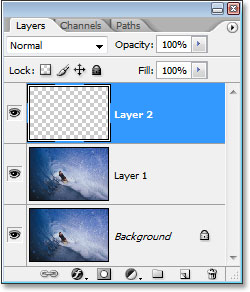
Printing "Shift+Ctrl+Alt+North" (Win) / "Shift+Command+Option+North" (Mac) to add a new bare layer.
Step 3: Fill The New Layer With White
We're going to make full our new layer with white, so printing the letter D on your keyboard to quickly reset your Foreground and Background colors if neccessary, so white becomes your Background color. Then, with "Layer ii" selected in the Layers palette (the currently selected layer is the ane highlighted), press Ctrl+Backspace (Win) / Control+Delete (Mac) to fill the new layer with the Groundwork colour, which in our case is white. Your prototype will at present be completely filled with white:
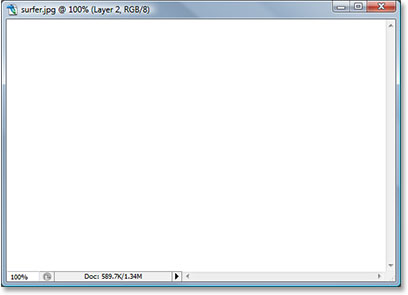
Press "Ctrl+Backspace" (Win) / "Command+Delete" (Mac) to fill the new layer with white, which volition also fill your image with white.
Step 4: Apply The "Add Noise" Filter
With our layer now filled with white, nosotros need to add some noise to information technology. Go up to the Filter card at the top of the screen, select Dissonance, and then select Add Dissonance, which brings upwards Photoshop's "Add Noise" dialog box. Drag the Amount slider all the way to the correct, and make sure that both the Gaussian and Monochromatic options at the bottom are selected:
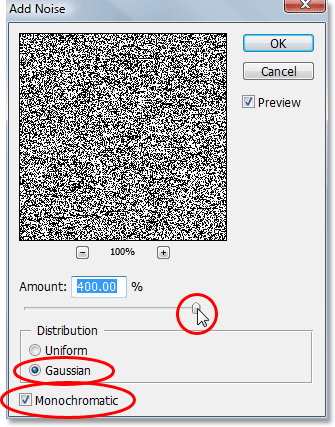
Go to Filter > Noise > Add Noise to bring up Photoshop'south "Add Noise" dialog box.
Click OK to exit out of the dialog box. Your image will now be filled with blackness racket:
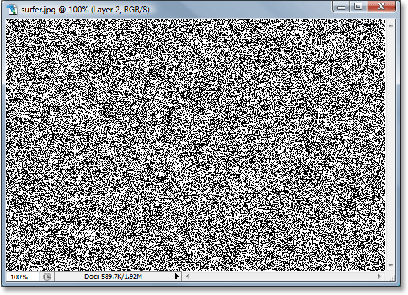
The image after adding noise.
Step v: Apply The "Gaussian Blur" Filter
Become back up to the Filter menu and this fourth dimension choose Blur and then Gaussian Blur, which brings up the "Gaussian Blur" filter dialog box. Drag the Radius slider to the right to increase the amount of blurring that's applied to the noise until all yous see is larger clumps of dark and light gray. I'm using a low resolution prototype for this tutorial, and for me, a value of about 6 pixels seems to work nicely. For high resolution images, you lot'll need to set your Radius value college to achieve the same upshot:
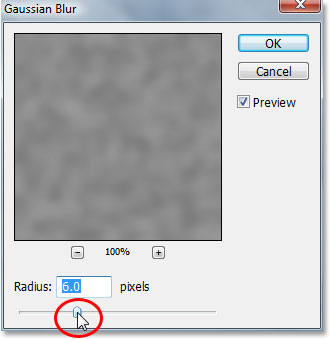
Get to Filter > Mistiness > Gaussian Blur to bring upwardly Photoshop'south "Gaussian Mistiness" dialog box.
Here'due south the effect you're trying to achieve:
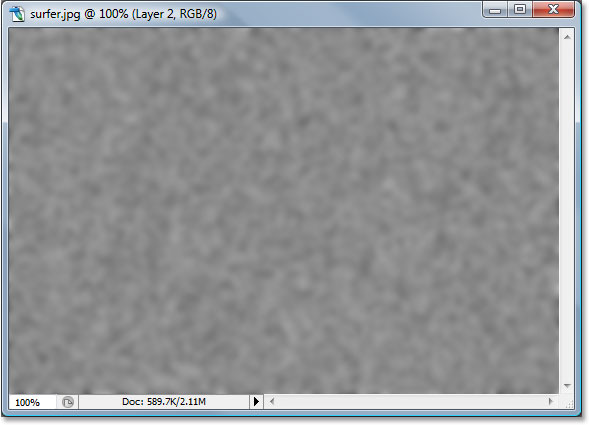
The epitome later on applying the Gaussian Blur filter to the noise.
Click OK to exit out of the Gaussian Blur dialog box.
Footstep 6: Apply A "Threshold" Prototype Adjustment
Go up to the Paradigm bill of fare at the height of the screen, choose Adjustments, and and so choose Threshold, which brings up the "Threshold" dialog box. The Threshold aligning turns everything in the image either black or white, and we're going to use it to create the basic shapes of our water drops. Click on the slider at the bottom of the Threshold dialog box and drag it either left or right to subtract or increment the size and number of black areas in the prototype. These black areas will become our h2o drops. Dragging the slider to the correct increases the size and number of black areas, and dragging to the left decreases them:

Go to Prototype > Adjustments > Threshold.
It'due south completely up to you how many h2o drops yous want in your epitome. When y'all're happy with how it looks, click OK to exit out of the dialog box. Here'south my paradigm after applying the Threshold aligning:

The paradigm later on applying the Threshold adjustment. All the black areas will get our water drops.
Footstep 7: Utilise A Slight Gaussian Blur To Smooth The Edges Of The Blackness Areas
The but problem with the Threshold adjustment is that it tends to get out us with very harsh, jagged edges, and of form water doesn't take harsh, jagged edges. It has polish edges, then nosotros demand to ready that, and we can fix it easily by just re-applying the Gaussian Mistiness filter. Since Gaussian Blur was the concluding filter we used, we can admission it quickly with the keyboard shortcut Ctrl+Alt+F (Win) / Control+Option+F (Mac), which brings up the filter's dialog box without applying information technology, giving the states a run a risk to modify the settings outset. We don't want to employ the same amount of blurring equally we applied initially since that'south mode too much. All we want to exercise here is smooth out any rough edges, and for that, we only need a hint of blurring. I'm going to set my Radius value to only 0.8 pixels this time:
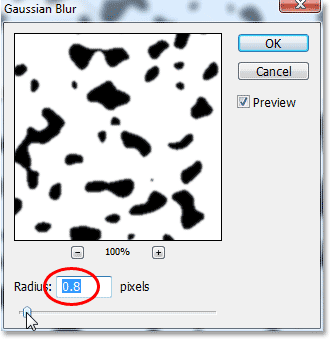
Utilize the Gaussian Mistiness filter again simply at a much lower setting to smooth out any rough, jagged edges around the black areas.
Click OK to exit out of the Gaussian Blur dialog box once once more.
Step viii: Select All The Black Areas With The Magic Wand
At present that we have the shapes which will become our water drops (the black areas), we can delete all the areas we no longer demand (the white areas). Start, let's select the blackness areas. To do that, we'll employ the Magic Wand. Select it from the Tools palette, or press Westward on your keyboard to quickly select it:

Select the Magic Wand.
Then, with the Magic Wand selected, wait up in the Options Bar at the top of the screen and make certain the Contiguous pick is non checked. We desire to select all the blackness areas with a single click, and if this option was selected, we'd have to become around clicking on each black area individually to add together it to the selection. So with "Contiguous" not checked, simply click on any black area in the image with the Magic Wand and Photoshop will select all of them at once:

Click on any black area with the Magic Wand to select all of them at once.
Step ix: Capsize The Selection And Delete The White Areas
Currently we have all of the black areas selected, but what we really desire is to have all the white areas selected and so nosotros can delete them. All nosotros need to do is capsize our choice, which will select everything that is not currently selected and deselect everything that is selected. In other words, the white areas will become selected and the black areas will exist deselected. To practice that, use the keyboard shortcut Ctrl+Shift+I (Win) / Command+Shift+I (Mac). All the white areas will now be selected.
And then printing Delete on your keyboard to delete all the white areas, leaving only the black shapes. Press Ctrl+D (Win) / Command+D (Mac) to deselect your option when yous're washed:
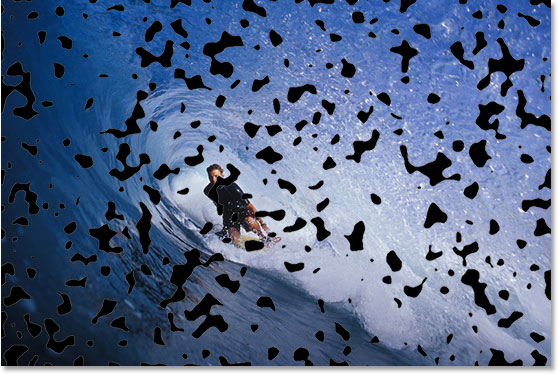
The image after deleting the white areas, leaving but the black shapes which will go our water drops in a moment.
Footstep 10: Lower The "Fill up" Of The Blackness Shapes Layer To 0%
In the height left corner of the Layers palette, you'll find 2 options - "Opacity" and "Fill". Both of these options command the visibility of a layer, with one important difference. If you were to lower the "Opacity" of a layer down to 0%, you would hide non only the contents of the layer but also any layer styles that were applied to it. The "Fill" option, on the other mitt, would hide only the layer contents. Whatsoever layer styles applied to the layer would remain visible, and that's exactly what nosotros want in order to create our h2o drops effect. We want to hide the actual black shapes themselves, merely we want the layer styles, which we'll be applying adjacent, to remain visible. Then to exercise that, become upwardly to the Fill option in the peak correct corner of the Layers palette and lower it all the way down to 0%:
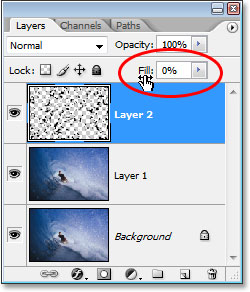
Lower the opacity of the black shapes layer down to 0%.
Your black shapes will disappear from view in your paradigm, but don't worry, they're still there, and we're going to be applying our layer styles to them side by side.
Step 11: Add together A Drib Shadow Layer Style
Click on the Layer Styles icon at the bottom of the Layers palette:
Click the Layer Styles icon.
Choose Drop Shadow from the listing of layer styles that appears:
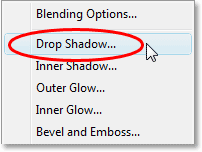
Select "Drop Shadow" from the list.
This brings up the Layer Mode dialog box set to the "Drop Shadow" options in the middle column. Lower the Opacity of the drop shadow downward to about 40% and fix the Angle to about 120°:
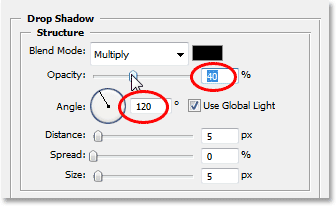
Set the options for the Drop Shadow circled in red in a higher place.
Don't click OK yet. Nosotros have a couple more layer styles to add together offset.
Step 12: Add A "Inner Shadow" Layer Style
Click direct on the words Inner Shadow on the left of the Layer Manner dialog box:
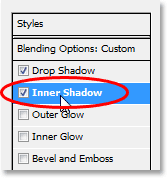
Click directly on the words "Inner Shadow" on the left of the Layer Style dialog box.
The options for the "Inner Shadow" layer style appear in the centre cavalcade. All nosotros want to do here is alter the Blend Fashion from "Multiply" to Overlay by clicking on the downwards-pointing arrow to the right of the word "Multiply" and selecting "Overlay" from the list:
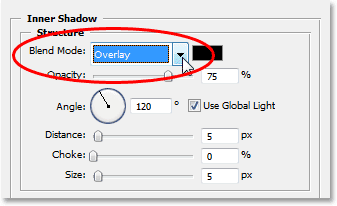
Change the "Alloy Way" of the Inner Shadow layer way to "Overlay".
Once more, don't click OK just nonetheless. Nosotros have 1 more than layer fashion to add.
Step thirteen: Add A "Bevel and Emboss" Layer Way
Finally, click straight on the words Bevel and Emboss on the left of the Layer Manner dialog box:
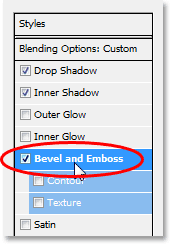
Click directly on the words "Bevel and Emboss" on the left of the Layer Way dialog box.
This brings up the "Bevel and Emboss" options in the eye column of the Layer Styles dialog box. Starting from the top and working our way down, change the Technique to Chisel Hard and and so raise the Depth to around 600% (if you find that's too loftier, finish making the remainder of the changes hither and so go back and adjust the Depth amount, keeping an eye on your image as you lot drag the slider). Increment the Soften amount to around 12 pixels to requite the water a nice smooth wait. Then, down near the bottom of the options, increase the Opacity of the Highlight Mode to a total 100%. Change the Shadow Mode to Color Dodge, and finally, modify the colour of the Shadow Mode from black to white by clicking on the color swatch and selecting white in Photoshop's Color Picker:

Modify the Bevel and Emboss layer fashion options circled in cherry-red higher up.
When you're done making the changes to the Bevel and Emboss options, click OK to exit out of the Layer Style dialog box. Your prototype will at present look something like this, with the water drops conspicuously visible:

The image after creating the main water drops event with layer styles.
Step 14: Erase Whatsoever H2o Drops You lot Don't Want
Now that I've created my water drops, I noticed that some of them are blocking the view of the primary subject of my image (the guy on the surfboard). I desire to remove those water drops, and I tin can do that easily by erasing them with the Eraser Tool. Grab your Eraser Tool from the Tools palette, or press East to quickly select it:

Select the Eraser Tool.
So, with the Eraser Tool selected, simply click and drag your mouse over any water drops you lot want to erase. I'grand going to erase the ones in front end of the surfer:
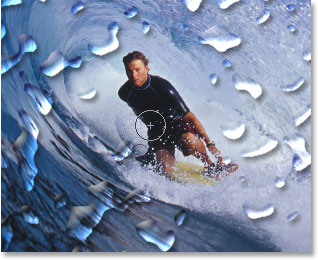
Utilize the Eraser Tool to remove whatever unwanted water drops.
Stride fifteen: Create A Displacement Map
The bones effect is complete at this point, but we can still go far look a flake more than realistic. If this was real water on a real photo, the h2o would exist causing the photo underneath information technology to look a little distorted, so let's add in that extra bit of realism using a displacement map, which is a scary sounding name for what is actually nothing more than a blackness and white image that we're going to create.
First, select all the h2o droplets at in one case by holding down the Ctrl (Win) / Command (Mac) primal and clicking on the h2o drop layer's thumbnail in the Layers palette:
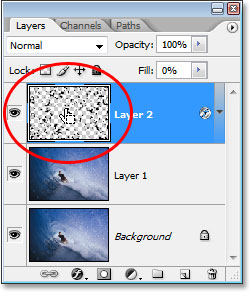
Hold down "Ctrl" (Win) / "Command" (Mac) and click on the water drop layer's thumbnail in the Layers palette.
This will place a selection around all of the h2o drops. Go up to the Select carte at the top of the screen, choose Change, and so cull Border. When the "Border Selection" dialog box appears, enter a value of near 10 pixels and then click OK:
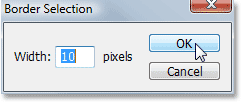
Add a 10 pixel border to the selection.
And then go back up to the Select menu and this time, choose Plume. Enter a Feather Radius value of about 4 pixels and click OK:

Enter a four pixel plume to the selection.
When you're done, go back upwardly to the Select carte one time over again and cull Salve Selection. When the "Save Pick" dialog box appears, just click OK to have the default options and exit out of it. Also, press Ctrl+D (Win) / Command+D (Mac) to deselect your selection around the h2o drops.
Now switch over to your Channels palette, which is grouped in beside the Layers palette, and you'll come across your saved pick at the very bottom in the channel named "Alpha 1". Click on it to select it:
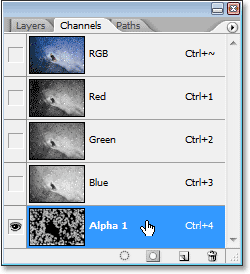
Click on the "Blastoff ane" channel, which is your saved selection, to select it.
Then click on the minor, correct-pointing pointer in the top right corner of the Channels palette and select Duplicate Channel from the list of options:
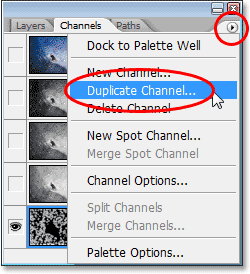
Click on the correct-pointing pointer in the top right corner of the Channels palette and select "Duplicate Channel".
When the "Duplicate Channel" dialog box appears, set the Certificate option to New, which is going to create a new document out of the channel, and then click OK:
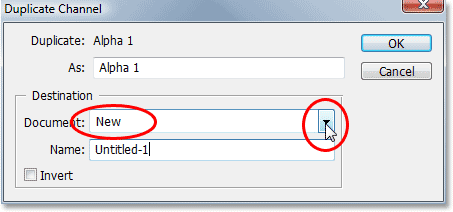
Click on the down-pointing arrow for the "Certificate" option and select "New", and then click OK.
The new document will announced on your screen. This is the document we're going to utilize for our displacement map. The only thing we accept left to do is save information technology, and so go upward to the File menu at the top of the screen and select Save As, or use the keyboard shortcut Shift+Ctrl+S (Win) / Shift+Command+Southward (Mac). Either way brings up the "Relieve As" dialog box. Name the document any you like. I'm going to name mine "water drops", and relieve the certificate to your desktop then you can access it easily, since we'll be needing information technology in a moment.
Once you've saved the new certificate, you can close out of it. We don't demand to have it open anymore.
Step 16: Utilise The "Displace" Filter To The Duplicate Groundwork Layer ("Layer 1")
Switch back to your Layers palette now and click on the duplicate Groundwork layer ("Layer 1") to select it. Nosotros're going to apply the "Readapt" filter to this layer, using the displacement map we just created and saved to the Desktop, which is going to requite us our water distortion issue. Go up to the Filter bill of fare, choose Distort, and then choose Readapt, which brings up the "Readapt" filter dialog box. Lower both the Horizontal Scale and Vertical Scale options down to about 8, and so make sure Displacement Map is set to Stretch To Fit and Undefined Areas is set to Repeat Edge Pixels:
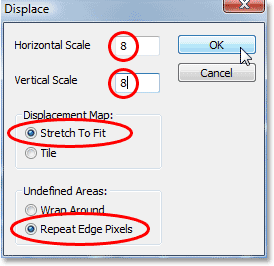
Go to Filter > Distort > Readapt to bring upwardly the Readapt filter dialog box.
Click OK to leave out of this dialog box, and a second dialog box volition appear asking you to select the displacement map you lot want to use. Cull the file y'all only saved to your desktop, then click Open, and Photoshop will apply the displacement map to the layer.
Pace 17: Delete The Areas On The Layer Which Are Not Under The Water Drops
The merely problem is, some of the distortion has been applied to the areas around the outside of the water drops, and we only desire the baloney to announced in areas that are directly nether the water drops, so we need to trim away the areas we don't want, and we can do that by but deleting the areas we don't want, just like we did back at the beginning when we deleted all the white areas around the black shapes. With "Layer 1" still selected, hold down your Ctrl (Win) / Control (Mac) key and click once again on the water drops layer's thumbnail to place a selection around all the water drops:
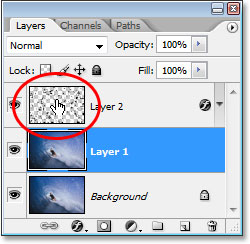
Concur down "Ctrl" (Win) / "Control" (Mac) and click on the water drop layer's thumbnail to select all the water drops.
Detect that even though we're clicking on the water drops layer's thumbnail, we still have "Layer 1" selected in the Layers palette, not the water drops layer.
The h2o drops are now selected:
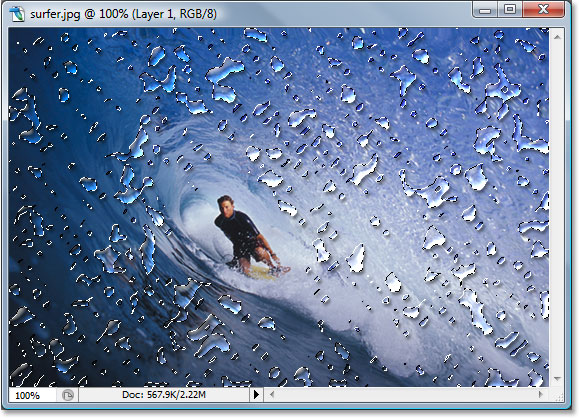
All the water drops are now selected in the image.
So, with the water drops selected, press Ctrl+Shift+I (Win) / Command+Shift+I (Mac) to invert the selection, so all the areas around the water drops become selected and the water drops themselves are deselected. Finally, press the Delete key on your keyboard to delete all the unwanted areas on "Layer 1", leaving only the areas nether the water drops, creating our h2o distortion effect, equally well as our concluding event:

The final "h2o drops" issue.
And in that location we have it! That's how to add realistic water drops to an image with Photoshop! Bank check out our Photo Furnishings section for more Photoshop furnishings tutorials!
Other Stuff
© 2022 Photoshop Essentials.com.
For inspiration, not duplication.
Site design by Steve Patterson.
Photoshop is a trademark of Adobe Systems Inc.
Source: https://www.photoshopessentials.com/photo-effects/water-drops/
Posted by: sanchezdeate1964.blogspot.com


0 Response to "How To Draw Water Drops In Sai"
Post a Comment